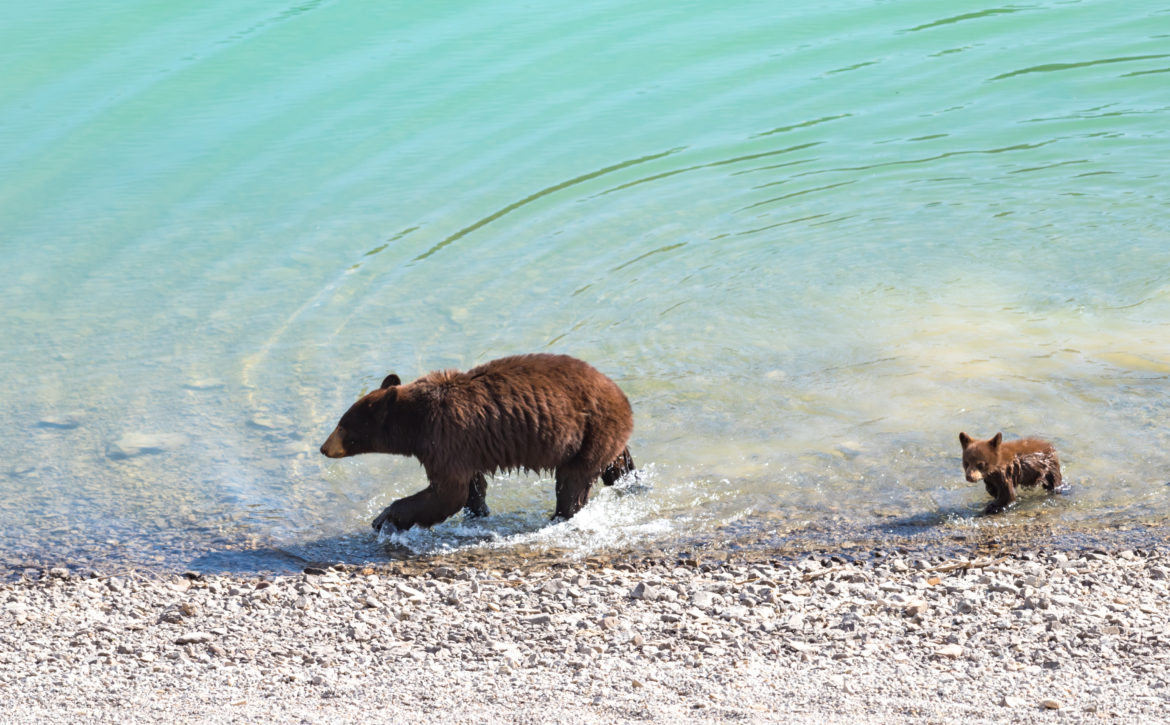
Those Bathing Bears Aren’t Cute. They’re Climate Change Victims.
Climate has always been one of Lake Tahoe’s biggest selling points. Nevada is infamously inhospitable to everyone but Elvis impersonators, and California is always burning. But North America’s largest alpine lake, which straddles the line between the arid states, stays mild year-round. Its townies, tourists, and resident wildlife were unprepared when a recent heat wave broke seven temperature records.On Sunday, as the mercury approached 90 degrees (more than 10 degrees above the typical summer peak), the masses took to the beaches of South Lake Tahoe, where a mother bear and three cubs made the unusual decision to join them. A viral video shows the animals lumbering past vacationers and into the frigid lake—the second such incident this summer. Watching the footage, it seems the bears were desperate; their need for relief overpowered their aversion to humans. (Then again, the four-legged family may have also been suffering from a mysterious new encephalitis that causes “dog-like behavior” and “fearlessness” in a growing number of Sierra Nevada black bears.) But ABC News producers packaged the footage differently: They recast the video with “happy, goofy xylophone music over it,” tweeted horror writer Mike Marano. In this version, the incident is not a funeral procession for the planet we knew—it’s an interspecies beach party.Cutesifying climate change is nothing new. Media outlets have suggested plenty of other aesthetic responses to the crisis this summer: Incorporate more materials like wicker in your interior design, The Wall Street Journal recently advised. Mix some jam-infused cocktails, Lifehacker recommended. And don’t forget to order a Greenco Giant Inflatable Pizza Slice, pro tip courtesy of the Today show. It’s clear that despite all the warnings, many people still think of lasting global warming as passing weather and any noteworthy consequences as a kind of hyperreal entertainment.The Tahoe bears are almost too on the nose: Gushing over animals driven to extremes fits with our anthropocentric attitude toward wildlife. Humans frequently try to befriend the 500-pound carnivores, transform them into fairy-tale creatures, and recast anomalous behavior—often driven by habitat loss, noise pollution, and empty-stomach opportunism—as selfie opportunities. The creatures we once hunted we now pester with iPhones. “Guns have metamorphosed into cameras in this earnest comedy, the ecology safari, because nature has ceased to be what it always had been—what people needed protection from,” Susan Sontag observed back in the 1970s. “Now nature—tamed, endangered, mortal—needs to be protected from people. When we are afraid, we shoot. But when we are nostalgic, we take pictures.” ABC News’s goofy xylophone music sounds a lot like a requiem.Environmentalism has always had a visual imperative. The World Wildlife Fund built its fundraising strategy on “charismatic megafauna”—elephants, tigers, and other big, beautiful “ambassador species” that humans like to look at and feel motivated to protect. From its inception, the National Park Service has prioritized the preservation of good views. “There can be nothing in the world more beautiful than the Yosemite, the groves of the giant sequoias and redwoods, the Canyon of the Colorado, the Canyon of the Yellowstone, the Three Tetons,” Theodore Roosevelt opined, “and our people should see to it that they are preserved for their children and their children’s children forever, with their majestic beauty all unmarred.” Even the widespread appeal of the trillion trees movement, an overly simplistic effort to offset carbon emissions with forest restoration, can be understood as a scenic crusade.Climate change seems to be accelerating our concerns about beauty as decay looms over our favorite landscapes. That’s not always a bad thing. “It may be,” environmental philosopher Emily Brady wrote in 2014, “that closer attention to the aesthetic properties linked to climate change, in spite of moral concerns, can enable an overall experience with greater emotional depth.”Visual media originally helped to create a lingua franca for climate change.But the crucial thing is for aesthetics to actually spur action. That’s something the modern GOP, incidentally, excels at: Republican arguments against climate action prioritize the creature comforts and familiar images we might lose in the process of reducing greenhouse gas emissions. A carbon tax might help preserve a landscape like Glacier National Park, this line of thinking goes, but it would come at the cost of first-class flights, brisket on the barbecue, or supersized SUVs with room for the whole family. The individual’s surroundings, which are so often dictated by what they can afford to see, take precedence over the environments we all share.Visual media originally helped to create a lingua franca for climate change, bringing images of melting glaciers and shrinking ice caps home. Lately, though, it’s struggled to advance the conversation. While innovations in data visualization can make invisible threats like carbon emissions feel real, photography continues to seek the beauty in everything—even when it shouldn’t be found. In June, The New York Times ran a story about Seattlelites scrambling for air conditioning units under a sumptuous sunset image of volleyball players on a local beach. A few days later, a “heat dome” explainer led with another backlit beach photo, this time of a giant red-and-white-striped parasol. The heat wave went on to kill at least 78 people in Washington alone—hundreds, by some estimates, across the region.Social media only further constrains our options for existential pondering. Even if we wanted to express something new, and could find the words or images to do it, platforms like Twitter, Facebook, and Instagram offer just one or two set templates in which to communicate the full breadth of human experience. A Facebook post announcing your loved one dying is structurally the same as a Facebook post about adopting a dog, because there is only one Facebook post. If ABC erred in trying to make the tragic seem adorable, it was only one step beyond the co-mingling of tragedy and cuteness on our timelines daily.I’ve spent most of my “shot girl summer” outside. I rafted down the Snake River, below the saw-toothed Teton mountains whose beauty Roosevelt sought to preserve. In Anchorage, Alaska, I saw my first bear “in the wild”—a visibly injured black bear searching for food in suburban trash cans.It was the Seattle heat wave that finally drove me indoors, checking myself and my dog into the only hotel room I could find, in a city where air conditioning is scarce. As the dog jumped back and forth between the two queen beds, I pulled the blinds down on the glimmering office buildings and feasted on the artificial cool. Aesthetics be damned: We were paying for peace of mind, in a room usually prized for its view.When we checked out on Tuesday, the weather was reasonable again. I’d had the money to “beat the heat” for the day. But unicorn-shaped pool floaties and custom margaritas won’t do anything to beat the heat permanently. For Tahoe’s bears and countless humans, a pricy hotel room isn’t an option. From the sixteenth floor of the Sheraton Grand, it was clear the most beautiful planet is a habitable one.
Read More


